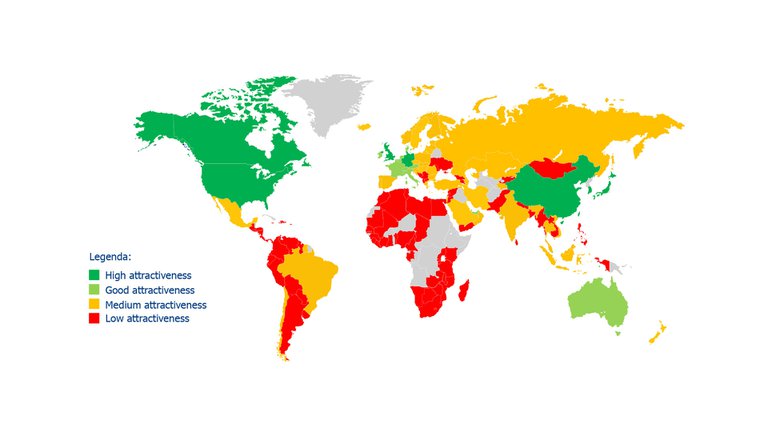RIO DE JANEIRO, BRAZIL – The 2020 edition – the fifth – of the Global Attractiveness Index (GAI), elaborated by The European House – Ambrosetti group, with the support of a number of large private companies, was released in Cernobbio, in the Italian Lombardy region. The GAI is designed as a map of 144 economies throughout the world, which seeks to measure and compare their potential in terms of investment and productive development.
The researchers in charge of preparing the index assign a score to the economies after taking into account several variables grouped into four categories: openness, innovation, talent and efficiency. But the score is relative: they assign 100 to the best one -which for the third consecutive year is Germany- and estimate how far the others are from it.

“In 2015, The European House – Ambrosetti launched the GAI, a country indicator that aims to measure and evaluate the attractiveness of 144 world economies from a more comprehensive perspective than mere economic appeal. A country’s appeal is, in fact, a concept that depends on a variety of economic factors, but also social, cultural, innovation, efficiency, capacity for openness and dialogue with foreign countries and the talent of each one,” the report states.
Germany has consolidated its position as number one in the GAI, both in terms of ranking and score. The United States, which was the leader until 2017, moved to second place, but is very close to first, totaling 99.61 points. However, the others are much further behind. For instance, the third-ranked country is Singapore, with a score of 90.51.
There are only six other economies listed as having “High Attractiveness” by the report’s authors: Japan (90.06), United Kingdom (89.17), Hong Kong (87.89), China (82.13), Canada (80.75) and South Korea (80.06). The ranking’s top ten is completed by the Netherlands, which, with 79.86 points -more than 20 below Germany-, moves to the next category: “Good Attractiveness”.
Far from these positions are the Latin American countries. Only three of the 19 assessed are among the 50 most attractive countries in the world: Brazil, which ranks 41st, with 44.74 points; Mexico, which ranks 43rd, with 43.46 points; and Chile, which ranks 46th, with a score of 39.80, over 60 points less than Germany. They are the only three in the region to be considered as “Average Attractiveness”. All the others are categorized as having “Low Attractiveness”, which means that few companies are interested in investing their money in these countries.
Nine rank between 50th and 100th: Uruguay (66th, 27.56), Panama (70th, 26.87), Dominican Republic (74th, 26.46), Peru (82nd, 24.87), Ecuador (84th, 24.42), Costa Rica (88th, 23.17), Colombia (91st, 22.51), Argentina (92nd, 22.15), and Paraguay (95th, 20.32). The remainder are among the worst performers worldwide: Guatemala (104th, 16.87), Bolivia (116th, 12.36), Honduras (120th, 11.13), El Salvador (122nd, 10.88), Nicaragua (130th, 9.34), Venezuela (137th, 5.74), and Haiti (141st, 4.35).
There are only three economies that are less attractive than Haiti’s: Guinea (3.22), Burundi (2.05) and Sierra Leone (0.14). And in addition to these four, there are only three others in worse conditions than Venezuela: The Gambia (5.61), Malawi (5.29) and Yemen (4.41). These are historically poor and unstable countries, which have experienced all kinds of political and armed conflicts since their independence. None of them has ever been a relatively prosperous democracy, as Venezuela was 20 years ago.
Latin America is not the only region in trouble. The report notes that the European Union (EU) is experiencing a process of declining attractiveness. Over the past five years, 75 percent of its member states have been declining or have remained stable in the ranking, and in the last decade, the European share of the global Foreign Direct Investment pool has declined from 43.7 to 30.7 percent.
In this context, the coronavirus came to aggravate many pre-existing issues in much of the world’s economies. The GAI tries to grasp the potential impact of the COVID-19 pandemic on the redesign of the attractiveness map, while uncertainty about the medium and long-term rebound capacity persists.
In the short term, the authors believe that a close look needs to be taken at what may happen with the growth of social inequalities, the increase in unemployment and the impact of the crisis on public finances and wages. These challenges will reduce the attractiveness of the most vulnerable economies in particular, but they also represent a major challenge for the more robust ones.
However, researchers note that the pandemic could have some positive consequences in certain development and competitiveness areas. Quarantines had three interesting effects: they encouraged the use of digital tools, contributed to reduce pollutant gas emissions and lowered the consumption of raw materials. Naturally, these trends will be reversed unless they are coupled with transformative and sustained reforms over time. But this may be the best time to move in that direction.
Source: infobae

